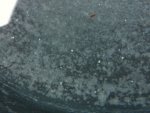I thought I had posted on this before but I guess I never did. I have always atributed this issue to calcium and I scrape it off but I am not sure anymore. Maybe someone here can help me eradicate it.
It's hard to get a picture but little white splotches appear on the plaster. This happens a lot over the winter when the pool is closed but they do also occur during the season. In the picture you can see the raised spots - all under the tile level - and some of them have a teardrop appearance or like melting wax. It is gritty and can be removed with a scrungie although I cant get them all and they are everywhere in the pool.
[attachment=0:19qzrxxc]photo (20).JPG[/attachment:19qzrxxc]
My chemistry is pretty much humming at this point but the only thing I grapple with in terms of fluctuation is the pH rising because of my SWG. I typically add MA weekly no matter what so the pH does swing rapidly over the week from maybe 7.2 to as high as 7.8-8.0 (occasionally)
Here are the latest numbers which have been pretty typical (other than the temp which is usually higher like 83 but we were away and the heat was off).
temp 76
pH 7.6
CH 250
CYA 70
FC 14.0
TA 100
CSI -0.15
Thanks a lot. :-D
It's hard to get a picture but little white splotches appear on the plaster. This happens a lot over the winter when the pool is closed but they do also occur during the season. In the picture you can see the raised spots - all under the tile level - and some of them have a teardrop appearance or like melting wax. It is gritty and can be removed with a scrungie although I cant get them all and they are everywhere in the pool.
[attachment=0:19qzrxxc]photo (20).JPG[/attachment:19qzrxxc]
My chemistry is pretty much humming at this point but the only thing I grapple with in terms of fluctuation is the pH rising because of my SWG. I typically add MA weekly no matter what so the pH does swing rapidly over the week from maybe 7.2 to as high as 7.8-8.0 (occasionally)
Here are the latest numbers which have been pretty typical (other than the temp which is usually higher like 83 but we were away and the heat was off).
temp 76
pH 7.6
CH 250
CYA 70
FC 14.0
TA 100
CSI -0.15
Thanks a lot. :-D


